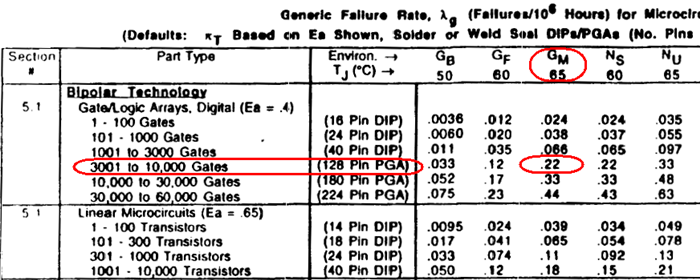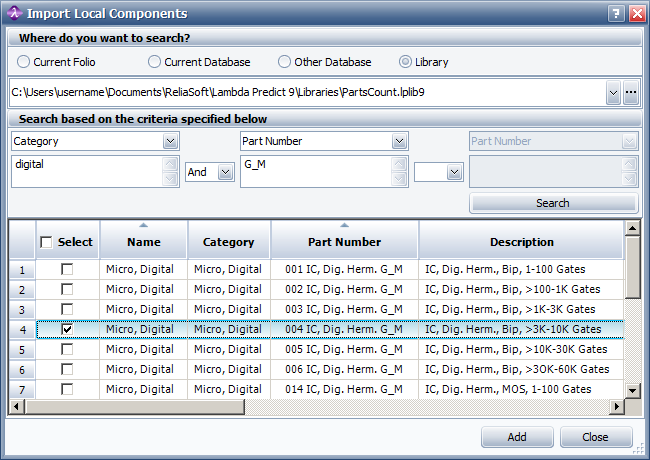

| Related Topics: | ||
In addition to providing full support for the MIL-217 part stress calculation method, Lambda Predict can be used to quickly create a MIL-217 parts count prediction. This analysis approach may be applicable during bid proposals and early design phases when sufficient information is not available to use the parts stress method.
To use the parts count method in Lambda Predict, you will need a copy of the "PartsCount.lblib9" library file, which is installed with the software and saved in the default documents folder for your computer (e.g., My Documents\ReliaSoft\Lambda Predict 9\Libraries). You will also need the following information:
Part type and quantity
Part quality level
Equipment environment
Number of years in production (for microcircuits only)
IMPORTANT: The parts count prediction method is based on the generic failure rates of components that were calculated using certain default parameter values. Therefore, if you edit the value of any fields other than those listed above, the analysis will be treated as a parts stress prediction rather than a parts count prediction.
Lambda Predict’s "PartsCount.lblib9" library file contains all the component part types and their default parameters for each environment. These correspond to the failure rates given in Appendix A of the MIL-HDBK-217F (Notice 2) handbook. For identification purposes, each component in the library file is identified by a part number that includes a component number, a short description of the component and an environment designation. For example, the library file uses the following part number for a bipolar gate/logic array with 4,000 gates:
004 IC, Dig. Herm. G_M
where:
004 represents the component number. This number is unique for each component type in the library file.
IC, Dig. Herm is short for "Integrated Circuit, Digital. Hermetic."
G_M stands for "Ground, Mobile" environment.
This component corresponds to the item described in Section 5.1 of Appendix A, as shown below.

The following example demonstrates how you can use the library file to perform a parts count analysis in Lambda Predict.
Assume you have four digital bipolar gate/logic arrays with 4,000 gates of Class S quality that have been in production for one year and will be operating in a Ground, Mobile environment.
To import this component for use with the parts count method, follow these steps:
Select a block ![]() or
the MIL-217 standard item
or
the MIL-217 standard item ![]() ,
and then choose System Hierarchy
> Local Components > Import Local Components.
,
and then choose System Hierarchy
> Local Components > Import Local Components.
![]()
In the Import Local Components window, select the Library option and browse for the PartsCount.lblib9 library file. Enter the following search criteria (the search is not case sensitive):
Category = digital
Part Number = G_M
Click the Search button. In the table of results, select the component, and then click Add to import it into the current prediction folio.

Now that the component's part type and environment have been specified, return to the prediction folio and change the value of the following properties:
Quantity = 4
Quality = Class S
Number of Years in Production = 1
According to the rules of the parts count prediction, these values can be changed as needed. The system hierarchy will show that the calculated failure rate for the component, based on the parts count method, is 0.3324 FPMH, as shown next.

Tip: You can update the properties for components that already exist in a prediction folio by matching the name, type and part number against the components that have been predefined in the library file. To do this, select the component and choose System Hierarchy > Local Components > Update Item, browse for the library file and click OK. To update the properties of all the sub-items under a block, select the block and choose the Update Branch command. Note that updating the properties will overwrite any existing data in those properties and cannot be undone.
Coils and mechanical relays use quality factors that are different than the values used for parts stress analysis. When you are using the parts count method and you wish to specify a quality level for these components, you must use the Adjustment Factor field instead of the Quality field.
For coils, use the following values for the adjustment factor:
MIL-217 Quality |
Adjustment Factor |
| Established Reliability | 0.25 |
| MIL-SPEC | 1.0 |
| Non-MIL | 3.0 |
For mechanical relays, use the following values:
MIL-217 Quality |
Adjustment Factor |
| Established Reliability | 0.6 |
| MIL-SPEC | 1.5 |
| Non-MIL | 2.9 |
© 1992-2015. ReliaSoft Corporation. ALL RIGHTS RESERVED.